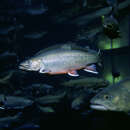Diagnostic Description
(
англиски
)
добавил Fishbase
Distinguished by the combination of dark green marbling on its back and dorsal fin and by the red spots with blue halos on its sides (Ref. 27547). Pelvic fins with axillary process; caudal nearly straight or with a shallow indentation (Ref. 27547). Color varies, but generally rather green to brownish on back, marked with paler vermiculations or marbling that extend onto the dorsal fin and sometimes the caudal; sides lighter than back, marked with numerous pale spots and some red spots, each of the latter surrounded by a blue halo; anal, pelvic and pectoral fins with a white leading edge followed by a dark stripe, the rest of the fins reddish (Ref. 27547). In spawning fish the lower sides and fins become red (Ref. 27547). Sea-run fish are dark green above with silvery sides, white bellies and very pale pink spots (Ref. 27547). Caudal fin with 19 rays (Ref. 2196).
- лиценца
- cc-by-nc
- авторски права
- FishBase
Diseases and Parasites
(
англиски
)
добавил Fishbase
Enteric Redmouth Disease. Bacterial diseases
- лиценца
- cc-by-nc
- авторски права
- FishBase
Diseases and Parasites
(
англиски
)
добавил Fishbase
Hysterothylacium Infection 8. Parasitic infestations (protozoa, worms, etc.)
- лиценца
- cc-by-nc
- авторски права
- FishBase
Diseases and Parasites
(
англиски
)
добавил Fishbase
Camallanus Infection 16. Parasitic infestations (protozoa, worms, etc.)
- лиценца
- cc-by-nc
- авторски права
- FishBase
Diseases and Parasites
(
англиски
)
добавил Fishbase
Whirling Disease 3. Parasitic infestations (protozoa, worms, etc.)
- лиценца
- cc-by-nc
- авторски права
- FishBase
Life Cycle
(
англиски
)
добавил Fishbase
Courtship begins with a male attempting to drive a female toward suitable spawning gravel. A receptive female chooses a spot and digs a redd. While the female is digging, the male continues courtship activity, darting alongside the female and quivering, swimming over and under her and rubbing her with his fins; most of the time however, is spent driving off other males. When the redd is completed, the pair enter the nest and deposit eggs and milt. After spawning the female covers the eggs by sweeping small pebbles at the downstream edge of the redd upstream. Once the eggs are completely covered, she moves to the upstream end of the redd and begins digging a new redd (Ref. 27547).
- лиценца
- cc-by-nc
- авторски права
- FishBase
Migration
(
англиски
)
добавил Fishbase
Anadromous. Fish that ascend rivers to spawn, as salmon and hilsa do. Sub-division of diadromous. Migrations should be cyclical and predictable and cover more than 100 km.
- лиценца
- cc-by-nc
- авторски права
- FishBase
Morphology
(
англиски
)
добавил Fishbase
Dorsal spines (total): 3 - 4; Dorsal soft rays (total): 8 - 14; Anal spines: 3 - 4; Analsoft rays: 8 - 14; Vertebrae: 58 - 62
- лиценца
- cc-by-nc
- авторски права
- FishBase
Trophic Strategy
(
англиски
)
добавил Fishbase
Inhabits cold, well-oxygenated waters of rivers, lakes and reservoirs (Ref. 30578). Anadromous (Ref. 5951). Feeding effort in juveniles is directed toward sub-surface, invertebrate drift (Ref. 28091). It is preyed upon by eels, white perch, yellow perch, chain pickerel, eastern belted kingfisher and American merganser (Ref. 5951).
- лиценца
- cc-by-nc
- авторски права
- FishBase
Biology
(
англиски
)
добавил Fishbase
Occurs in clear, cool, well-oxygenated creeks, small to medium rivers, and lakes (Ref. 5723, 86798). Nerito-pelagic (Ref. 58426). Anadromous in some populations (Ref. 86798). In its native range, general upstream movements have been observed in early spring, summer and late fall; downstream movements, in late spring and fall (Ref. 28546, 28548, 28549, 28550). Some fish, popularly known as salters, run to the sea in the spring as stream temperature rises, but never venture more than a few kilometers from river mouths. It may remain at sea for up to three months (Ref. 28546, 28549, 28551). Feeds on a wide range of organisms including worms, leeches, crustaceans, insects (chironomids, caddisflies, blackflies, mayflies, stoneflies and dragonflies (Ref. 5951), mollusks, fishes and amphibians (Ref. 3348, 10294); also small mammals (Ref. 1998). Stomachs of some individuals contained traces of plant remains (Ref. 1998). There are reports of introduced fish reaching 15 years of age in California, USA (Ref. 28545). Cultured for food and for stocking (Ref. 27547). Extensively used as an experimental animal (Ref. 1998). Marketed fresh and smoked; eaten fried, broiled, boiled, microwaved, and baked (Ref. 9988).
- лиценца
- cc-by-nc
- авторски права
- FishBase
Importance
(
англиски
)
добавил Fishbase
fisheries: minor commercial; aquaculture: commercial; gamefish: yes; aquarium: public aquariums; price category: very high; price reliability: questionable: based on ex-vessel price for species in this genus
- лиценца
- cc-by-nc
- авторски права
- FishBase

